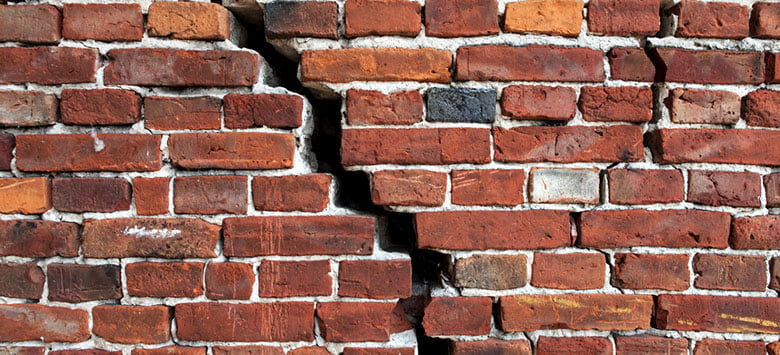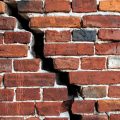
Brick buildings give a presence of sturdy structures. With many homeowners embracing the “exposed brick” look on their homes, there are bound to experience some problems. Brick cracks are a common issue for brick walls. While this problem doesn’t always indicate serious structural damage, cracked brickwork can make your home prone to water damages and mould.
There are two main ways brick walls form cracks – either through a natural disaster like earthquakes or with time.
Most of the time, the cracks in your brick wall can be fixed, so it shouldn’t be a significant problem. However, it’s not a problem to underestimate, as cracks tend to spread and become larger quickly.
Types of wall cracks
There are different types of wall cracks, and all of them can be defined on their location, form and depth.
Depending on their location
Depending on their location crack walls can be classified as:
- Interior wall cracks – a type of cracks inside your house. They can appear on plasterboard, ceiling, etc.
- Exterior wall cracks – they appear on the outside of your house, on brick walls, masonry, concrete, etc.
- Foundation wall cracks – these are cracks that appear in the foundation walls and are the ones that can cause serious problems.
Types of cracks by direction
Every brick wall is held together with mortar in between the bricks. Most often, that mortar breaks and that’s the cause of the problem. The problem is that mortar related problems are prone to become bigger over time, which may lead to serious structural damage.
Horizontal brick cracks
Horizontal cracks are caused by movements in the foundation and the depreciation of materials affecting the walls. They often appear on older houses as the materials tend to lose their stretch with the years.
Vertical brick cracks
Vertical cracks are most often met in warmer climates. Their characteristic is that vertical bricks can appear in the mortar and brick, effectively splitting the brick in two. Almost always, vertical cracks are caused by thermal expansion, which leads to movement of the material, which results in vertical cracks.
Brick veneer cracks
Brick veneer cracks are zig-zag cracks that follow the mortar line around the bricks. While this crack may seem a simple fix, as they appear only in the mortar, it’s often the telltale sign of serious structural damage.
Types of cracks by depth
Structural
Structurally related cracks can cause big problems for homeowners. They are often deep and affect the structural strength of the building, sometimes even making it unsafe to live in. They often appear after an earthquake or because of a badly build structure in the first place.
Cosmetic
Cosmetic cracks are often only just that – cosmetic. Often caused by sudden changes in temperatures or by constant exposure to extreme heaths, this crack does not affect the house’s structure and is often regarded as an easy fix. Keep in mind, however, that neglected cosmetic cracks can turn into structural cracks with time.
What causes cracks in brick walls
Soil subsidence
It all starts with the construction of the house. To place the foundations of a building, soil excavation has been done. With time the ground settles down, and the foundation of the house moves a little. This movement can cause small vertical cracks, often not a problem.
Depending on the type of soil that your house is built upon, your house may experience more drastic movement, that can damage the house significantly.
Natural disasters like earthquakes, floods and hurricanes can damage the foundation of your house significantly.
Climate and seasonal changes
The materials that our houses are built with respond quite a lot to the climate conditions and seasonal changes. Rain and water can damage both the walls and foundations, as well as long periods of drought.
Corrosion and deterioration of building materials
Building materials don’t last forever. Weather, gravity and bad maintenance impact our structures constantly.
The building reinforcement is prone to corrosion, especially if the concrete foundation is not done properly. Cracks in the foundations, expose the steel reinforcement to moisture which can cause rusting and may lead to brick wall cracks.
Construction works in your area
If you live close to a construction site, this can affect the brick walls. The vibration from the regular use of heavy machines, excavation, digging etc may cause your brick walls to crack.
Reactive soils in your area
Some types of soils, such as clay, are reactive to moisture because it expands when moist and cracks and shrinks when dry.
If your house is built on clay soil, this reaction may cause it to move slightly and cause the appearance of small wall cracks.
Luckily, in most cases, these types of cracks are only cosmetic and can be fixed easily. If the cracks are wider than 3 mm and grow over time, you should take the problem seriously and call a professional to inspect your property.
Trees close to the house
Big trees close to your house can contribute to brick wall cracking. Their root structures are invasive and can damage the foundation of your house. They also need a lot of water, thus can affect the moisture in the soil.
As we mentioned above, dry soil can also cause wall cracks.
How to repair cracks in brick walls
Tools you need:
- Safety Goggles
- Raking Bar
- Chisel
- Hammer
- Wire brush
- Brick Jointer
- Pointer
How to repair cracked brick walls step-by-step
- Remove the cracked mortar from the brick wall
Remove the old cracked horizontal mortar from the joints using a raking bar. Be careful not to damage the bricks and don’t go deeper than 1.5 – 2 cm in the wall.
Remove the vertical joints at the end of the bricks as well. To do so, use a chisel and a hammer. Tap the chisel with the hammer until you crack the mortar. Don’t go deeper than 1.5 – 2cm. Use a wire brush and gently scrub the empty joints to ensure all the excess mortar is removed.Pro tip: Make sure all the excess mortar is removed. This way, you’ll avoid air or water in the space behind it and will prolong the life of your wall. - Spray the brick wall
After all the mortar is removed, you’ll need to spray the wall with water. A dry brick wall will suck up all the water from the new mortar, causing the wall to crack all over again.
- Patch the joints with mortar
After the mortar is mixed well and matches your wall colour, take a brick jointer and push the mortar into the joints. Be careful not to leave any empty holes.
When mixing the mortar, don’t make it too hard. As we mentioned, bricks tend to expand depending on the weather conditions, and if the mortar is too hard, it will crack again and cause even further damage. - Point the brick wall
Put some water on the pointer and push it into the joint to flatten the mortar.
When cracked brick walls become a problem
The size, location and direction of the cracks can help you identify when you need to take immediate actions, but sometimes brick wall cracks can affect your whole house.
As we mentioned above, brick wall cracks can be a cause of a serious problem, or cause one in the future.
Doors and windows
If doors or windows are sticking or can’t be opened or closed properly, and the problem is not in the interior of your home, this can be a sign of a structural movement.
Walls and ceiling
If nails or screws are popping out of the walls, or if you notice cracks in the interior walls or ceiling, this can also be a sign of a serious issue. Cracks between the walls and the ceiling is a sign of a structural issue.
Floors
Cracked, swelling floors are also a problem giveaway. You can check if the floor is even by rolling a ball across the whole room. If the ball doesn’t go straight to the other end of the wall, then you have a problem.
How can you prevent brick walls from cracking
To prevent brick walls from cracking make sure you’re taking the proper care of your house’ walls.
Use expansion joints in the brick walls
Expansion joints will prevent the wall from cracking when exposed to temperature changes and moisture exposure.
Remove all temporary shims
Make sure all temporary shims used when building the property are removed from the walls. Most of the shims are made of stainless steel, and removing them will prevent the wall from rusting and cracking,
Don’t use incompressible materials in the joints
Fireboard, veneer and similar materials are not flexible. Avoid using them in the joints to prevent cracking.
How much does it cost to fix cracked bricks
Repairing brick wall cracks can be very expensive if there are structural problems in your property. So don’t ignore the problem! Fixing brick wall cracks as soon as you notice them can save you tons of money.
Sometimes repairing the crack from the outside is a temporary solution to a serious problem. So be sure to call a professional handyman to inspect the condition of your property.
Have that problem? Book Fantastic Handymen
The professionals deal with cracked brick walls on a regular basis.
You can book our handyman services in Melbourne, Sydney, Brisbane and Perth!



I thought it was interesting how you said that some types of soil are reactive to moisture and can cause cracks in the brick. My father has been remodeling his house so that he can sell it and retire with my mother. His house is made of bricks, so it might be a good idea for him to hire a company that specializes in brick to fix his house.
I love that you talked about how foundation cracks are the ones that can cause serious problems. in the structure of your house. I’ve heard that big trees can damage the walls of your house. Thanks for the advice on calling a professional to inspect the condition of your property before paying more money to fix the whole structure.
It’s good to know that you can identify how severe a crack is by its size and direction. My brother has been telling me about how he wants to get a brick wall installed in the coming weeks. I’ll share this information with him so that he can look into his options for professionals who can help him with this.
Look, everyone knows foundation problems SOUND scary But the truth is most homes have foundation issues Yes, zigzag cracks in the brick and visible cracks in the foundation are obvious… But if the home has carpet, or laminate, or flooring of ANY KIND, can you really be sure there aren’t foundation cracks? Truth is, foundation repair isn’t always that big of a deal. You can get a (in my opinion) quick, cosmetic fix with cement piers for about $4 a square foot in the absolute worst case that you need piers throughout the entire structure. This is what you do… Read more »
Loved your Post!
The information shared is really helpful and rich in content.
Looking forward for more blogs.
This is great information. Is it true that moisture affects the brick integrity?
Yes, moisture slowly but surely weakens the structural integrity. It can cause brick spalling and cracked walls.
Not as comprehensive as I would have hoped from a “complete guide.” But thanks.
Hi, Jay. Sorry the article didn’t meet your expectations. What else would you like to know?
Hi, we have vertical crack on external wall on our double storey house
Hi, Sindhu. We’re sorry to hear that. How big is the crack? Have you found a solution. If not, maybe we can help you.
Foundations need to be variable depending on soil structure and depth to rock where applicable. One side of your house may have a 400mm footing that is on rock, where as the other side may have a 400 deep footing that is 1m above the rock. This is an all to common issue. Piers within footings down to rock will overcome this issue. It’s essential that all sides of your house have the same bearing capacity. Modern regulations now require expansion joints in brickwork at regular intervals which lessens the occurrence of external cracks. Underpinning foundations can be undertaken to… Read more »
Thank you for sharing that.